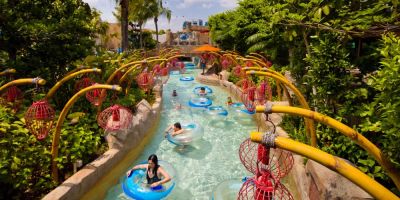- 1-Understanding-Risks-at-Busy-Water-Parks
- 2-Preparation-Before-Your-Visit
- 3-Safety-Tips-During-Your-Water-Park-Visit
- 4-Managing-Crowds-and-Avoiding-Accidents
- 5-Real-Life-Stories-Highlight-Safety
- 6-Resources-for-Water-Park-Safety-Products
1. Understanding Risks at Busy Water Parks
Water parks during busy seasons can be thrilling but also present unique safety challenges. Crowded spaces increase the risk of accidents such as slips, collisions on rides, or difficulty supervising children. Overwhelmed lifeguards may find it harder to monitor every guest effectively, which calls for extra vigilance from visitors.
Recognizing these risks is the first step in learning how to stay safe at water parks during busy seasons. Awareness helps families prepare better and adopt safer behaviors in these lively environments.

Sun-N-Fun Lagoon
15000 Livingston Rd, Naples, FL 34109, USA
2. Preparation Before Your Visit
Proper preparation sets the tone for a safe day at the water park. Research the park’s layout, rules, and busiest hours to plan your visit strategically. Booking tickets online for off-peak times can reduce exposure to large crowds.
Pack essentials such as waterproof sunscreen, water shoes to prevent slipping, and flotation devices for non-swimmers. Discuss safety rules with children beforehand, emphasizing the importance of staying close and following staff instructions.

Disney's Blizzard Beach Water Park
Bay Lake, FL 32836, USA
2.1 Health and Hydration Considerations
Staying hydrated is vital, especially in hot weather. Bring refillable water bottles and encourage regular breaks to avoid heat exhaustion or dehydration during your visit.
3. Safety Tips During Your Water Park Visit
While enjoying the attractions, maintain constant supervision of children and stay within designated safe zones. Use wristbands or GPS trackers for young kids in large parks to prevent losing sight of them.
Adhere strictly to height and weight restrictions on rides to avoid injuries. Always enter pools feet first and be cautious on wet surfaces to minimize slipping risks.
3.1 Communicating Emergency Plans
Establish a meeting point in case anyone gets separated. Teach children how to identify lifeguards and where to seek help.
4. Managing Crowds and Avoiding Accidents
Busy water parks often mean long lines and congestion. Practice patience and remain calm to prevent accidents caused by rushing or pushing. Encourage children to wait their turn and respect personal space.
Use less crowded attractions as alternatives and visit popular rides early in the day. This approach reduces stress and increases safety for everyone.
5. Real-Life Stories Highlight Safety
At a popular summer water park, a family’s quick response and preparedness prevented a potential mishap when their young child wandered off. Thanks to prior discussions about meeting points and recognition of staff uniforms, the child was safely reunited within minutes.
Another visitor shared how choosing off-peak hours drastically improved their experience and safety, allowing them to supervise their kids closely without feeling overwhelmed by the crowd.
6. Resources for Water Park Safety Products
For those seeking reliable water park safety gear, Water Park offers an extensive selection of products like child-friendly flotation devices, waterproof phone cases, and non-slip footwear. Their expert guidance helps families prepare for busy seasons with the best tools to ensure a safe and enjoyable visit.










